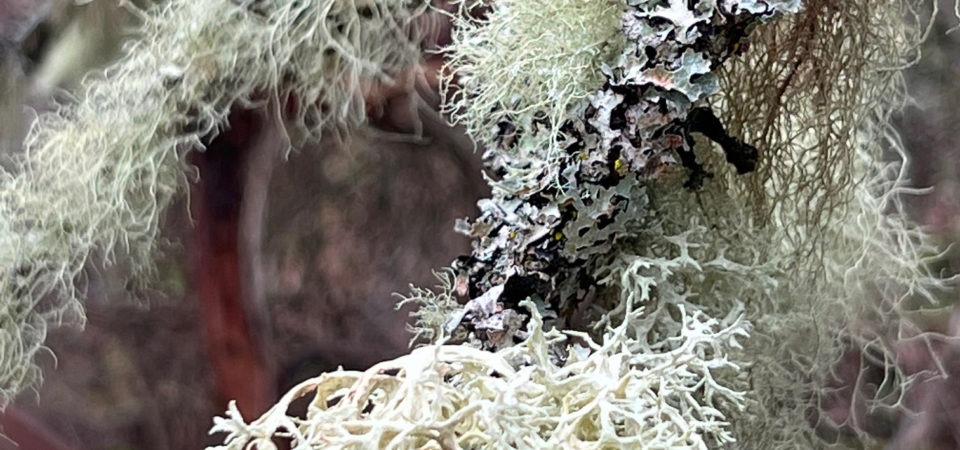During a cascade of world crises and endless news of suffering in many different regions, a walk in one’s home community, whether urban or rural, can settle the body, calm the mind, and uplift the heart. Where we reside is, too, our primary locus of influence where familiar design ideas take form in buildings, in landscaping, in infrastructure to support industry and human settlement, and in our ideas of amenities and about what can be obliterated. As a counterbalance, a walking practice dedicated to witnessing unfurlings displaces the urge to make conventional.
Pentad 19 excerpt — Lilies Fawning
“There’s a fresh growth of ferns, their small, bright fronds clothing a stony hill nearby. Amidst them, spaced like introverts among strangers, are delicate stems, each topped with a single blossom: here a fawn lily, there a fawn lily. Until this year, I didn’t know the kinship story that explains their name: their leaves are spotted like the camouflage pattern on a newborn deer.”
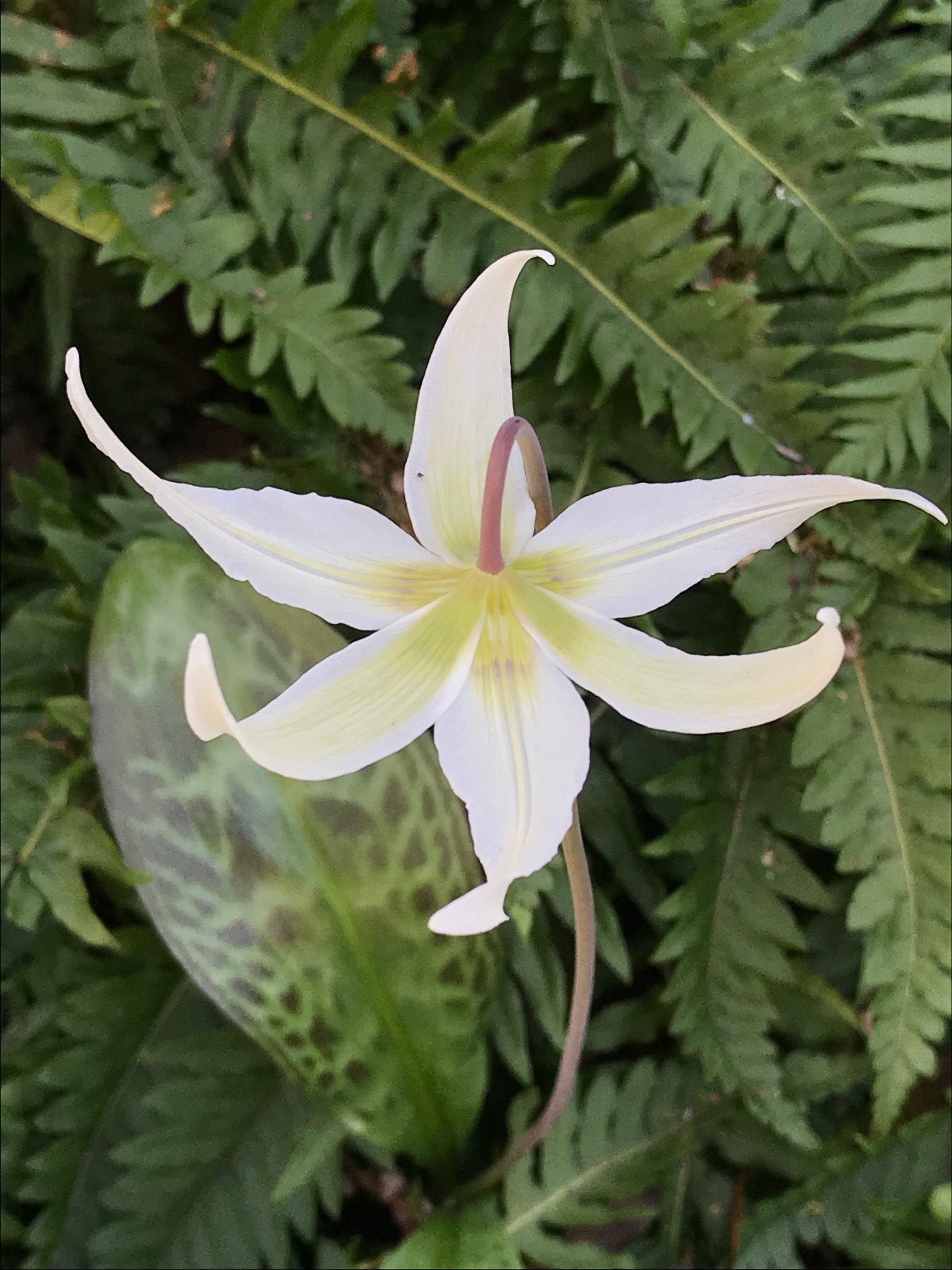
Pentad 19: Lilies Fawning
The Japanese micro-season calendar of Ko begins on February 4 with Risshun, known as the Beginning of Spring. I began mine on January 4: a parallel calendar where the North American bio-region called Cascadia faces Japan across the Pacific, its Canadian edge including my Vancouver Island home.
Pentads occupy two genres: prognostic and poetic. Each describes a subtle ecosystem pattern that reveals itself over a few days. To delineate pentads is to seek intimacy with visible life forms. My attempt, I anticipated, would sharpen my understanding of my proper place in creation as Albert Schweitzer described all of humankind’s: “life that wills to live amidst life that wills to live.” Still, how could I possibly capture seventy-two such changes in a year?
Japanese feudal administrators imported from imperial China their first calendar and with its 24 seasons, gave their own scholars the basis for eventually identifying 72 micro-seasons, each typically lasting five days. Each is named for a change in weather or the flow of water as well as air (e.g., “east wind melts the ice”) or the activity of creatures or plants (e.g., “frogs start singing,” “bamboo shoots sprout”).
To begin, at 72 calendar intervals, I flagged a 48-hour period in which I had to write an illustrated post (scientific and contemplative) about that particular 5-day season. I committed to walking in all weather. Rather than a sketchpad, my pocket always held a smartphone camera to capture near and far views that would help refine the descriptors for each shift. I walked multiple times per pentad, mostly alone, in forests and parks, along waterways and cliffs, and through meadows and lanes. When, very rarely, I felt unwell or not free to leave my desk for long, I stood on my porch and noted birdsong, animal movements, scents, wind, and light quality. I also plumbed my photo archive for same-date, same-place images.
Daniel Christian Wahl, author of Designing Regenerative Cultures, has said that none of us can “save a world”: we can only “save places.” My conscience has nudged me for years: “What does Earth require of me? What does befriending this biosphere mean?” To learn of respect and honourable harvesting in practice—to “save” any place—I first have to know it: how its ecology works, what wants to happen here, what is healthy, what is sorely degraded, what has long occurred in rhythmic cycle, what might stop happening, and why.
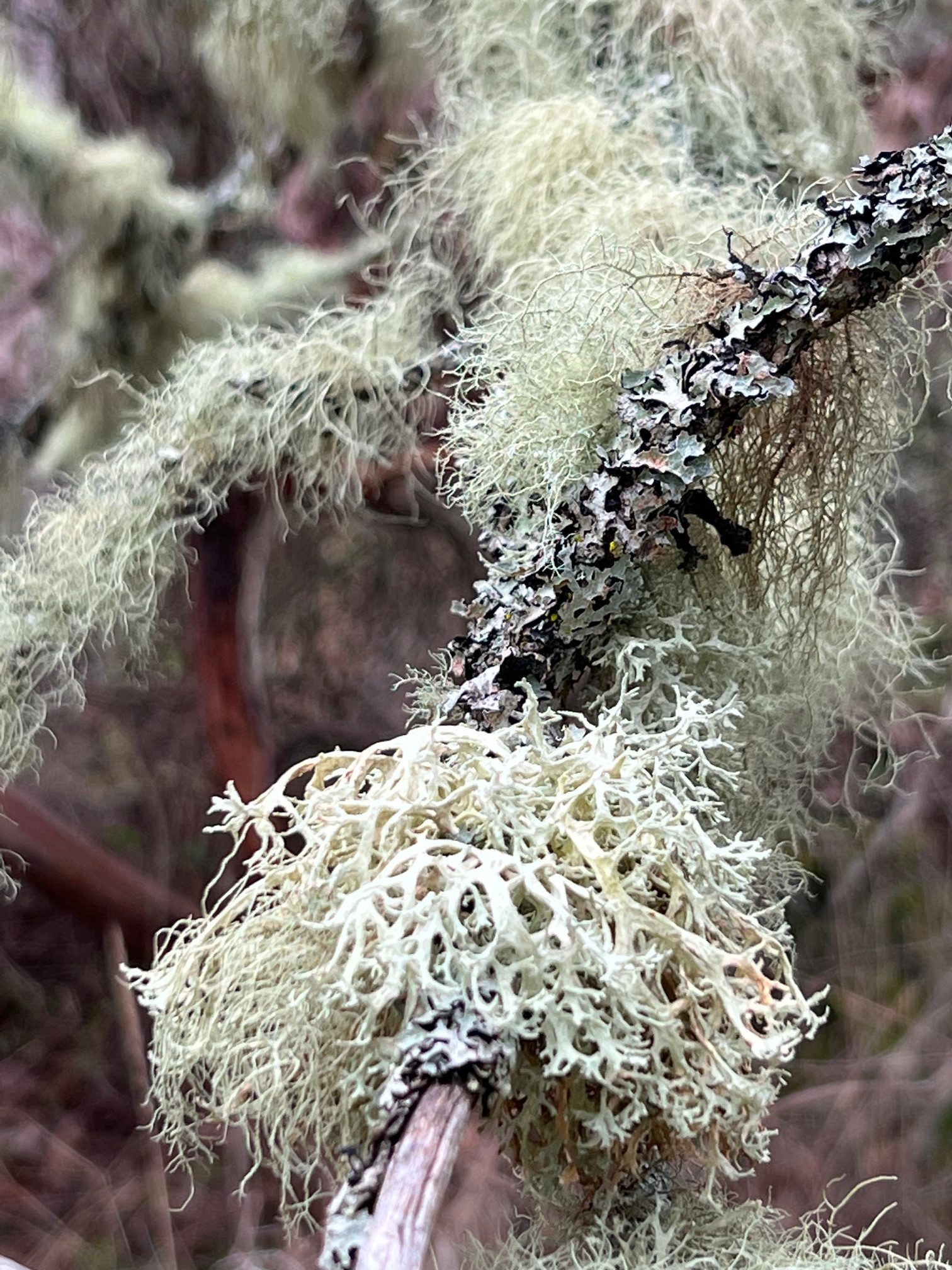
Pentad 13 — Lush Lichen
A fungus, an alga, a mold: a lichen lesson about expanding alliances.
What is an example of a distinctive change to witness
in a specific bioregion?
I perked up my ears when a biologist friend mentioned the uniqueness of the flora in the small meadow where early Chinese settlers held their burials in view of the sea. I could not have expected, nor did she, that three government botanists — one a former colleague of my friend — would choose that day to visit the same site for marking off patches of endangered species. They arrived as I was on my hands and knees looking at the tiny flowers of three species which, my friend told me, grow nowhere else in the world but in this small meadow and nearby Trial Island.
The friendly botanists were flagging other prize specimens around me and prompting me until I finally spotted my first. The blooms, star-like and brilliant magenta, were so small I could have fit about one hundred of them onto the nail of my pinky finger.
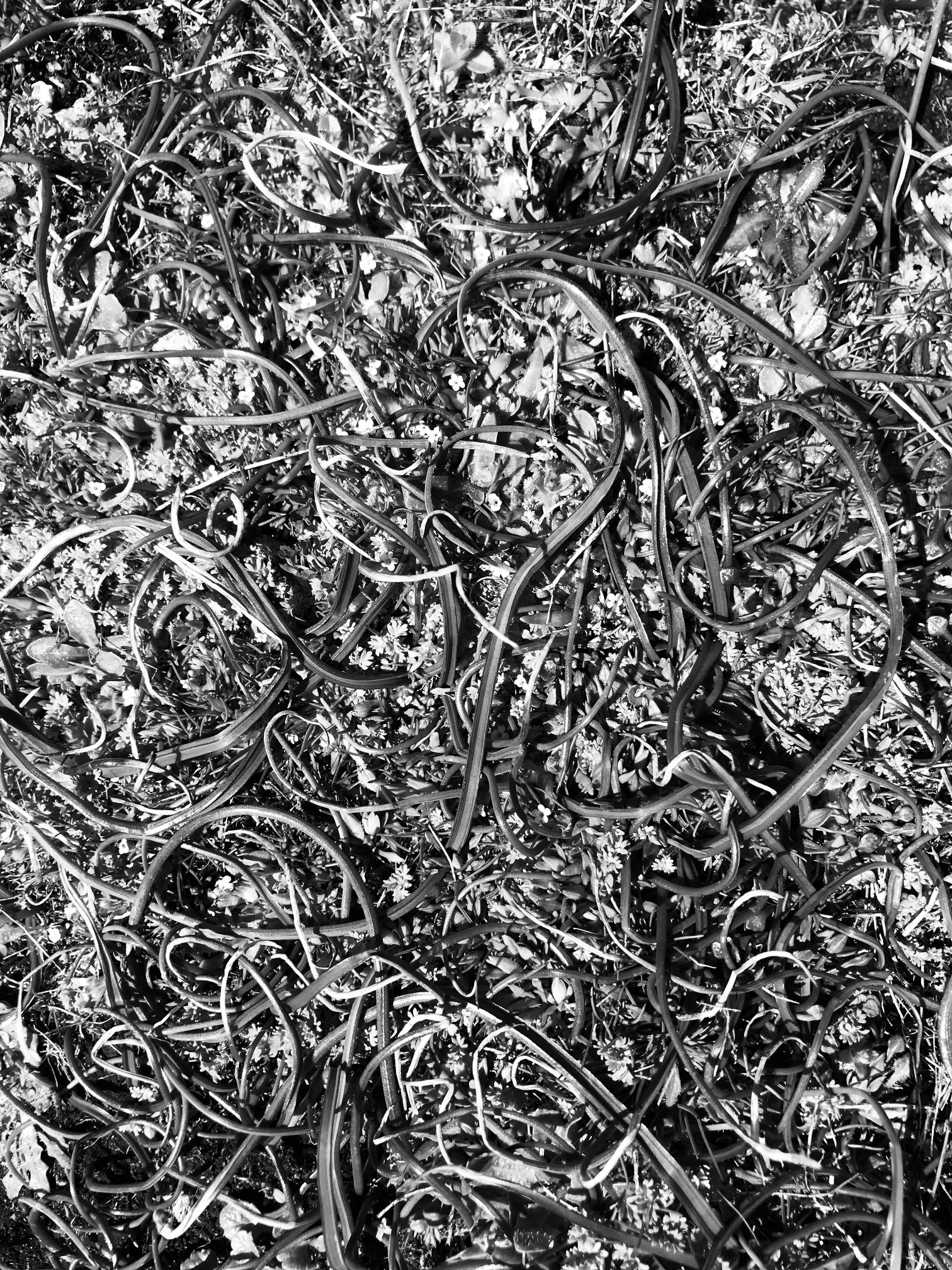
Harling Point groundscape on southern Vancouver Island,
British Columbia, Canada
It amazed me that these botanists, each over six feet tall, could see the flowers. The endangered plants in that ecosystem are so tiny that only when they bloom can most non-scientists distinguish them from other compact species. Their entire period from bud to die-back is only about ten days—one pentad to bud, a second pentad to blossom—and then they seem to sink back into the earth. Of what value is such a species, and why should anyone trouble to remove invasives so that this modest plant might live?
This endemic plant is the sole source of a medicine used to treat a particular form of lung cancer. It can heal humans who are devastatingly ill. Its life holds a mighty purpose.
Pentad 15 excerpt — March 17-21 — Lanterns in the Swamp
Mere yellow sticks, the ankle-height slivers leap in height overnight and widen with flame-like curves. . . . With Lysichiton americanus, Mother Earth dramatizes regeneration, rising from muck as it has for 245 million years, and reassures us that Nature provides, even though brightening the muck—whether mental, political or material—may always be necessary.
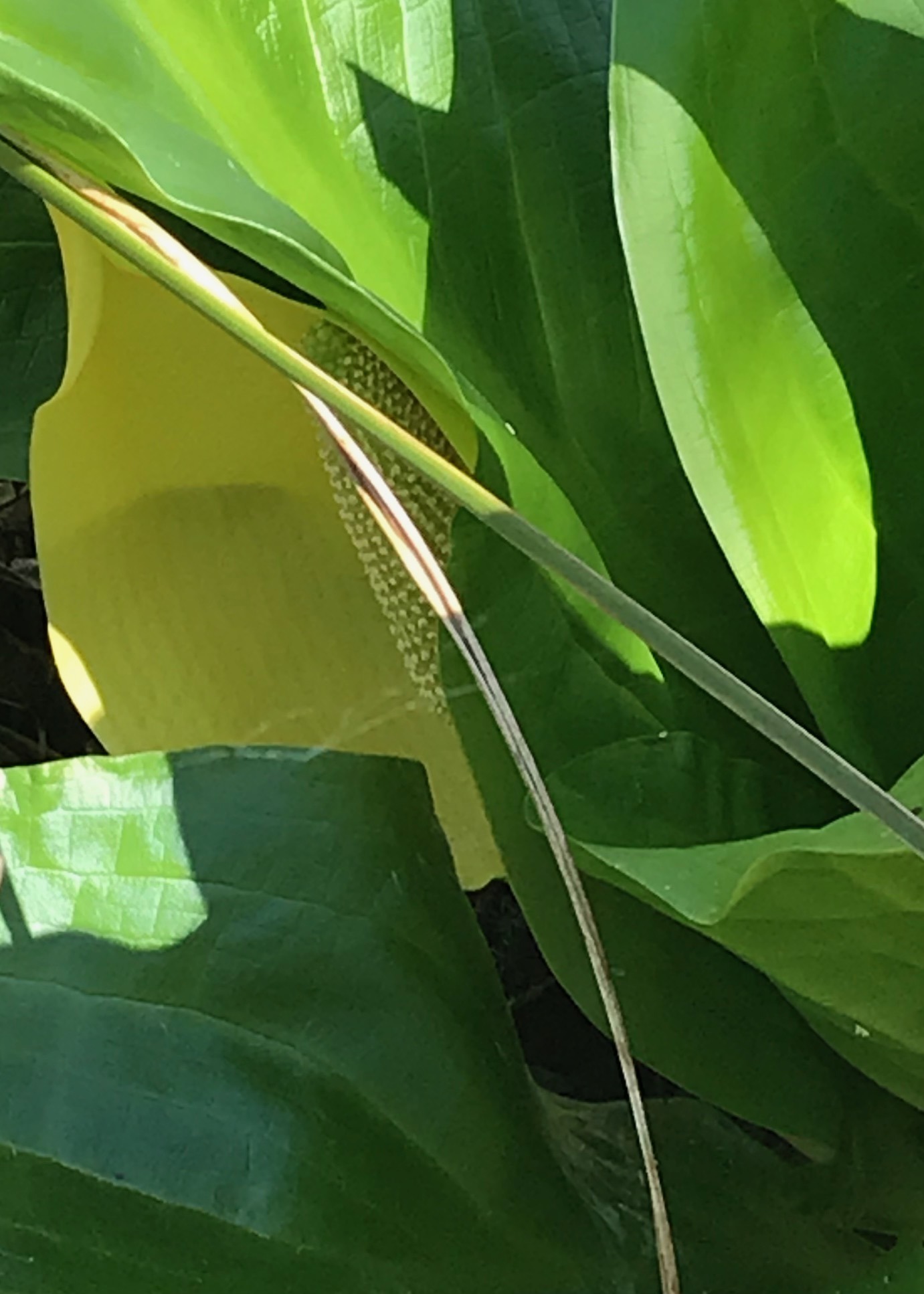
Pentad 15 — Lanterns in the Swamp
Gardeners like me are schooled to expect waves of growth and to impose designs by planting species together that come from distant ecosystems. To create a pentad calendar, one must devalue the familiar in favour of the nearby and often overlooked.
In visual terms, one must widen one’s view and must practice, in pentads, catching peripheral flashes, a “flirt” of vibrancy embodying the seasonal change. A flirt might draw me into a channel other than the visual. A sound, a scent, a movement, an appearance, a tactile magnet: all can be pentad particulars.
One needn’t publish noticings, but the decision to do so frequently made me more attentive and more accountable for knowing distinctions: localized or regional? new, or characteristic? a resurgence or a vestige?
Over the year, I noted blossoms on endemic trees I had long admired for their bark, not their bloom. I learned when vanilla leaf makes forest floors luminescent, when mature stipes of bull kelp rose from the ocean floor to form surface mats, when vernal pools filled, when horned owls fledged, and when fog begat the first days of white mystery.
I learned more about ocean reforestation, wetland preservation, and food foraging. I learned where and when to walk for the greatest nourishment but also, by revisiting those sites, how I might create year-round garden beauty with native plants. I noticed, too, what I didn’t know. What native fruit is this? What spears are rising from the wetlands, and how are those hollow stalks useful?
Pentad 18 excerpt —April 1-5 — Mahonia Lights Up
Berberis aquifolium, known also as Mahonia aquifolium, is hardy, remarkably tenacious, without being invasive. . . . It teaches what we humans need for the cultivation effort that lies ahead of us.

Pentad 18 — Mahonia Lights Up
Witnessing pentad changes enchanted me to an unexpected degree. After filling months of the Gregorian calendar with pentads, I grew lighter in spirit. I began to feel as I had during my final boat excursion near the end of many long sojourns by the Sea of Cortes. Gone for that season were the awe-inspiring blue whales that were a frequent objective of such outings for me in Mexico. I was without touring ambition, simply seeking relief from extreme humidity on land.
Winds change fast there. In the far distance, the sea appeared full of whitecaps. Our panga skipper discerned otherwise. Delfines! He sped closer, then cut the motor. We drifted a long while in silence. The whitecaps approached us: not dozens but hundreds, and hundreds becoming thousands. A picazon, a feeding frenzy! A thousand birds were hovering over several thousand porpoising dolphins. In the centre of the movement, up came a pod of humpback whales, jaws agape as they found their feast of fish and krill.
The unsustainable state of the world had been filling me with foreboding, yet these flocks and pods seemed to be declaring: Look, we know how to regenerate here. We know the meaning of flourishing. We are abundance.
On pentad perambulations, I feel more at one with everything that supports regeneration: de-growth advocates, the Half-Earth initiative, gardeners demonstrating “We Are The Ark,” the legislators of offshore and watershed protections. Honouring their work and joining with others to celebrate and increase its incidence, I feel growing trust in a flourishing future for all beings. This is the gift of pentad perambulations—a gift of nothing less than joy.
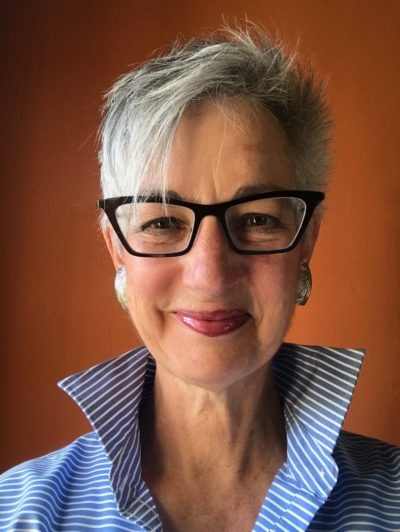 Sylvia Holland has been a textile artist, a program designer and evaluator, a manager of restorative justice programs and mediator within the criminal justice system, a professional facilitator of large system changes, and a teacher in community engagement for urban design and community planning. Her facilitation practice aligned government ministries, industry associations, not-for-profit community organizations, downstream stakeholders, and post-secondary educational institutions for work on diverse change initiatives.
Sylvia Holland has been a textile artist, a program designer and evaluator, a manager of restorative justice programs and mediator within the criminal justice system, a professional facilitator of large system changes, and a teacher in community engagement for urban design and community planning. Her facilitation practice aligned government ministries, industry associations, not-for-profit community organizations, downstream stakeholders, and post-secondary educational institutions for work on diverse change initiatives.
Design has been the central thread of her life: fabrics and clothing, programs and venues, bigger spaces and places, new ways of doing business, multi-media resources, landscapes. Her continual focus has been on collaborative design processes, including the recognition of disturbance as a creative force.
Her formal education has been in sociology, adult learning, community and regional planning, business administration, landscape architecture and urban design. Now retired as a facilitator, she currently practices the arts of writing (principally creative non-fiction) and the intertwining of text with photographic images into visual essays.
Sylvia is a volunteer moderator within the Deep Transformation Network, a longtime supporter of Programs in Earth Literacies, an irrepressible learner in many disciplines (at present a participant in ETH Zurich’s Designing Resilient Regenerative Systems course series), and an advocate in her local community of multiple forms of “hub resilience” whereby strangers become allies and able to weather crises together.
The creation of pentad calendars is a new pursuit for Sylvia, building on earlier photo essays titled “Re-Placing Ourselves.”
Sylvia is reachable at sylvia.e.holland@gmail.com
This article is part of the MAHB Arts Community‘s “More About the Arts and the Anthropocene”. If you are an artist interested in sharing your thoughts and artwork, as it relates to the topic, please send a message to Michele Guieu, Eco-Artist and MAHB Arts Editor: michele@mahbonline.org. Thank you. ~

